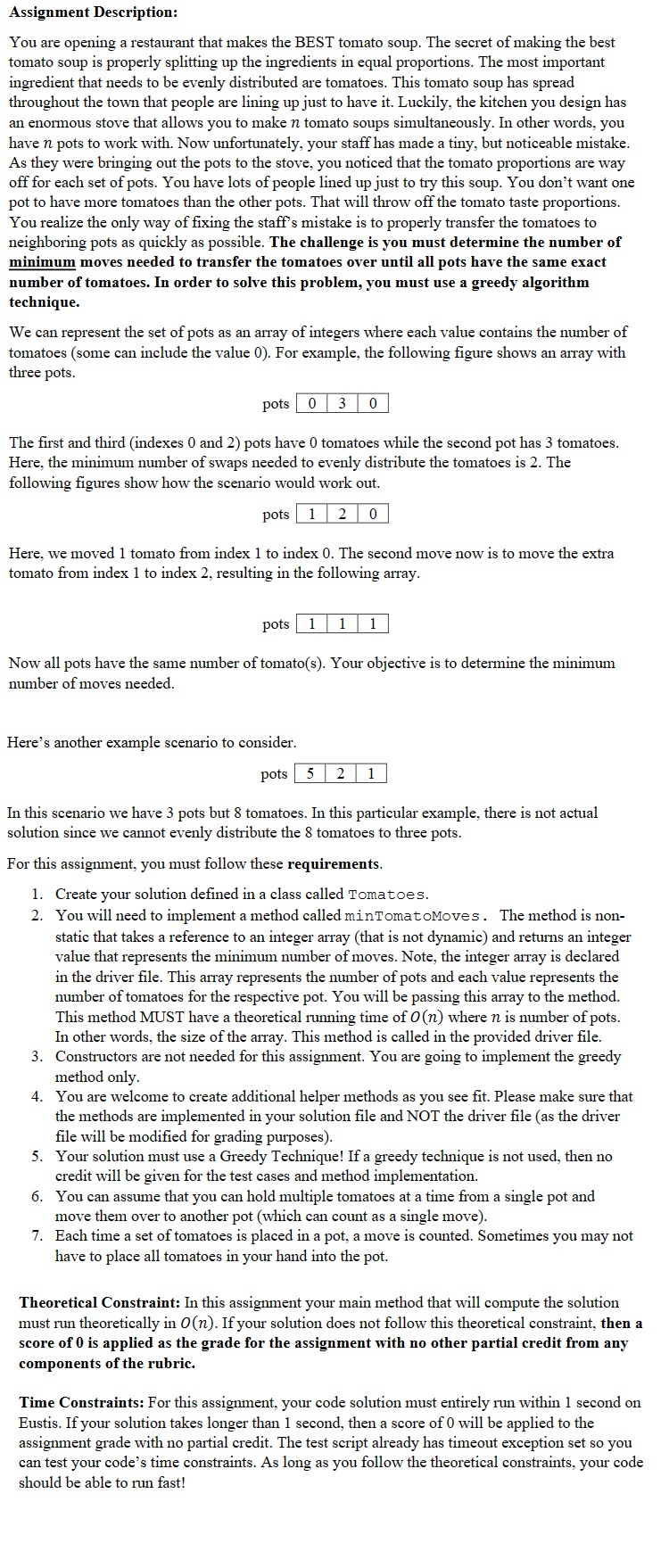Answered step by step
Verified Expert Solution
Question
1 Approved Answer
Assignment Description: You are opening a restaurant that makes the BEST tomato soup. The secret of making the best tomato soup is properly splitting up
Assignment Description:
You are opening a restaurant that makes the BEST tomato soup. The secret of making the best
tomato soup is properly splitting up the ingredients in equal proportions. The most important
ingredient that needs to be evenly distributed are tomatoes. This tomato soup has spread
throughout the town that people are lining up just to have it Luckily, the kitchen you design has
an enormous stove that allows you to make tomato soups simultaneously. In other words, you
have pots to work with. Now unfortunately, your staff has made a tiny, but noticeable mistake.
As they were bringing out the pots to the stove, you noticed that the tomato proportions are way
off for each set of pots. You have lots of people lined up just to try this soup. You don't want one
pot to have more tomatoes than the other pots. That will throw off the tomato taste proportions.
You realize the only way of fixing the staff's mistake is to properly transfer the tomatoes to
neighboring pots as quickly as possible. The challenge is you must determine the number of
minimum moves needed to transfer the tomatoes over until all pots have the same exact
number of tomatoes. In order to solve this problem, you must use a greedy algorithm
technique.
We can represent the set of pots as an array of integers where each value contains the number of
tomatoes some can include the value For example, the following figure shows an array with
three pots.
pots
The first and third indexes and pots have tomatoes while the second pot has tomatoes.
Here, the minimum number of swaps needed to evenly distribute the tomatoes is The
following figures show how the scenario would work out.
pots
Here, we moved tomato from index to index The second move now is to move the extra
tomato from index to index resulting in the following array.
pots
Now all pots have the same number of tomatos Your objective is to determine the minimum
number of moves needed.
Here's another example scenario to consider.
pots
In this scenario we have pots but tomatoes. In this particular example, there is not actual
solution since we cannot evenly distribute the tomatoes to three pots.
For this assignment, you must follow these requirements.
Create your solution defined in a class called tomatoes.
You will need to implement a method called minTomatomoves. The method is non
static that takes a reference to an integer array that is not dynamic and returns an integer
value that represents the minimum number of moves. Note, the integer array is declared
in the driver file. This array represents the number of pots and each value represents the
number of tomatoes for the respective pot. You will be passing this array to the method.
This method MUST have a theoretical running time of where is number of pots.
In other words, the size of the array. This method is called in the provided driver file.
Constructors are not needed for this assignment. You are going to implement the greedy
method only.
You are welcome to create additional helper methods as you see fit. Please make sure that
the methods are implemented in your solution file and NOT the driver file as the driver
file will be modified for grading purposes
Your solution must use a Greedy Technique! If a greedy technique is not used, then no
credit will be given for the test cases and method implementation.
You can assume that you can hold multiple tomatoes at a time from a single pot and
move them over to another pot which can count as a single move
Each time a set of tomatoes is placed in a pot, a move is counted. Sometimes you may not
have to place all tomatoes in your hand into the pot.
Theoretical Constraint: In this assignment your main method that will compute the solution
must run theoretically in If your solution does not follow this theoretical constraint, then a
score of is applied as the grade for the assignment with no other partial credit from any
components of the rubric.
Time Constraints: For this assignment, your code solution must entirely run within second on
Eustis. If your solution takes longer than second, then a score of will be applied to the
assignment grade with no partial credit. The test script already has timeout exception set so you
can test your code's time constraints. As long as you follow the theoretical constraints, your code
should be able to run fast!

Step by Step Solution
There are 3 Steps involved in it
Step: 1

Get Instant Access to Expert-Tailored Solutions
See step-by-step solutions with expert insights and AI powered tools for academic success
Step: 2

Step: 3

Ace Your Homework with AI
Get the answers you need in no time with our AI-driven, step-by-step assistance
Get Started


